Gnats! Oh, what a nuisance! If the question ever crossed your mind: What is the purpose of gnats, or why do they even exist? Don’t worry — you’re not alone. Gnats, those tiny, pesky insects that appear out of nowhere and in great numbers, swarm around our heads on warm summer days.
While these minuscule creatures can annoy humans, they play a crucial role in our environment. This article will explore the fascinating world of gnats and uncover their hidden purposes in the delicate balance of the Earth’s ecosystems.
From their roles as pollinators to their contribution to nutrient recycling, gnats significantly impact the natural world, which might surprise you. Join me and sit tight as we delve into the fascinating world of gnats.
What Are Gnats?
Gnats are flying insects from the families Mycetophilidae, Anisopodidae, and Sciaridae. All these families are from the order Diptera (derived from the Greek meaning ‘two wings’). Some gnats bite, and others do not, but they are still a nuisance and irritation to humans. The order Diptera also includes larger flies, such as the common housefly, fruit flies, and mosquitoes.
A gnat’s tiny body is usually about a quarter inch or sometimes even smaller, and its color ranges from gray to black. This insect is equipped with one set of flying wings, and they tend to fly in large groups or swarms. Gnats are longer-legged than the fruit fly or the common housefly.
While some species of gnats are harmless, others can bite or transmit diseases. You will most likely find gnats near various moisture and organic matter sources, making them common around decaying plants, fruits, damp areas, and even indoor potted plants.
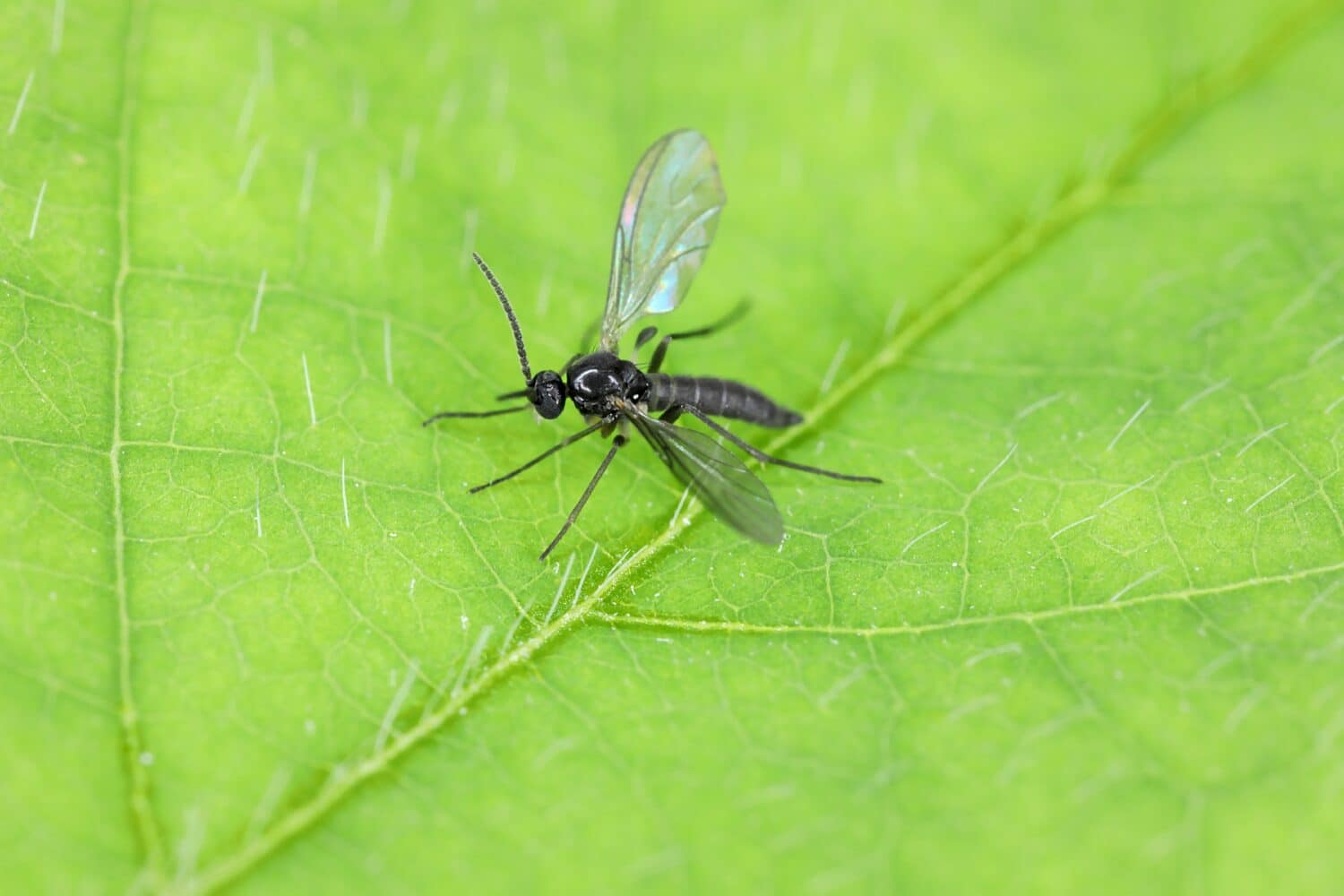
Gnats are minuscule flying insects from the order
Diptera, meaning ‘two wings.’
©Tomasz Klejdysz/Shutterstock.com
Ecological Purpose of Gnats
Believe it or not, there is a purpose of gnats. Although gnats are often regarded as pesky insects due to their tendency to swarm and annoy, they hold a vital ecological role in the natural world. These tiny, winged creatures, found in various habitats and locations worldwide, serve multiple environmental purposes.
Some types of gnats, especially those with specific shapes of mouth parts, can play a role in pollinating various plants. Although gnats will not be as effective as bees or butterflies, they can still facilitate the reproduction of certain plant species by transferring pollen from one flower to another.
Gnats serve as a food source for various other animals, including birds, bats, spiders, and other insects. They are an essential component of food chains and ecosystems, helping support the survival of these predators.
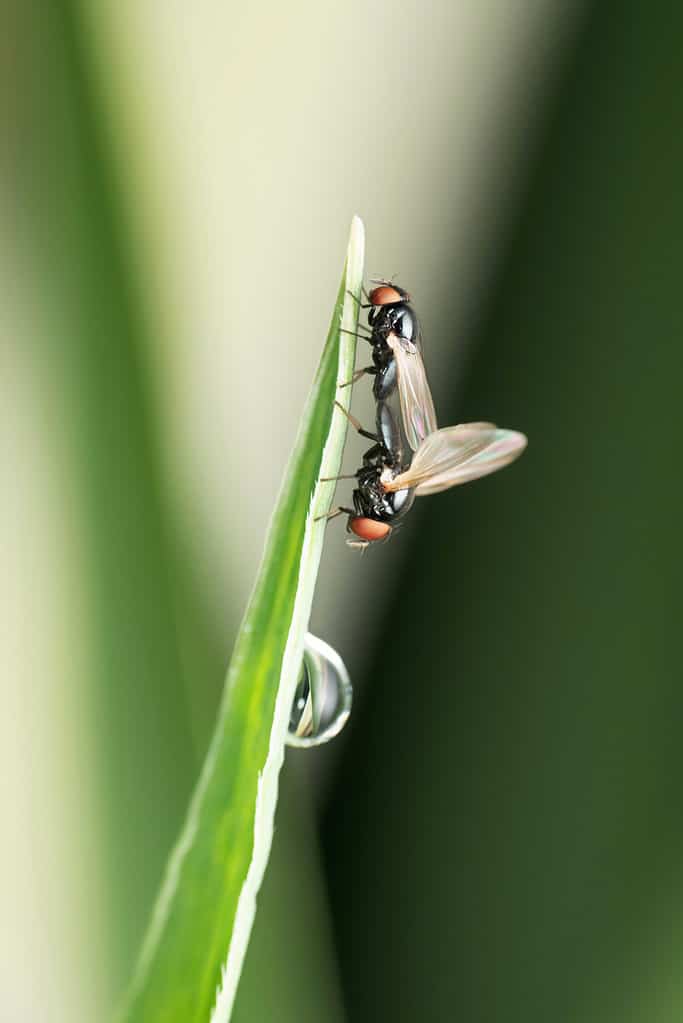
Gnats are part of Earth’s rich tapestry of biodiversity.
©RealityImages/Shutterstock.com
By feeding on decaying organic matter, including dead plants and animals, gnats contribute to the decomposition process. This behavior helps break down organic material and recycle nutrients into the ecosystem, making these humble insects important decomposers in many environments.
Another purpose of gnats is they aid in dispersing seeds of certain plant species by carrying seeds from one location to another on their bodies or digestive systems. In addition, the presence or absence of certain gnat species can be regarded as an indicator of environmental conditions. For example, the abundance of aquatic gnats (midges) in freshwater ecosystems can indicate water quality and pollution levels, which allows those monitoring the water to develop strategies to remedy these situations.
Why Do Gnats Swarm?
There are several reasons for gnats to swarm, and it depends on the species and environmental conditions. Here are some of the main reasons why gnats swarm.
- Many gnat species form swarms as part of their mating behavior. Male gnats typically gather in swarms, releasing pheromones or engaging in aerial displays to attract females. Female gnats then enter these swarms to choose a mate. Swarming increases the likelihood of successful mating by bringing males and females together.
- Swarming can help gnats and other small flying insects navigate. Gnats can collectively assess wind direction, temperature, and other environmental cues by forming swarms. This behavior helps them avoid unfavorable conditions and locate suitable breeding or feeding sites.
- There are also ecological reasons why gnats need to swarm. Gnats are an important element in the overall food chain in nature. By flying as a swarm, these tiny insects can become a more visible and available food source for predators like birds, bats, and other larger insects.
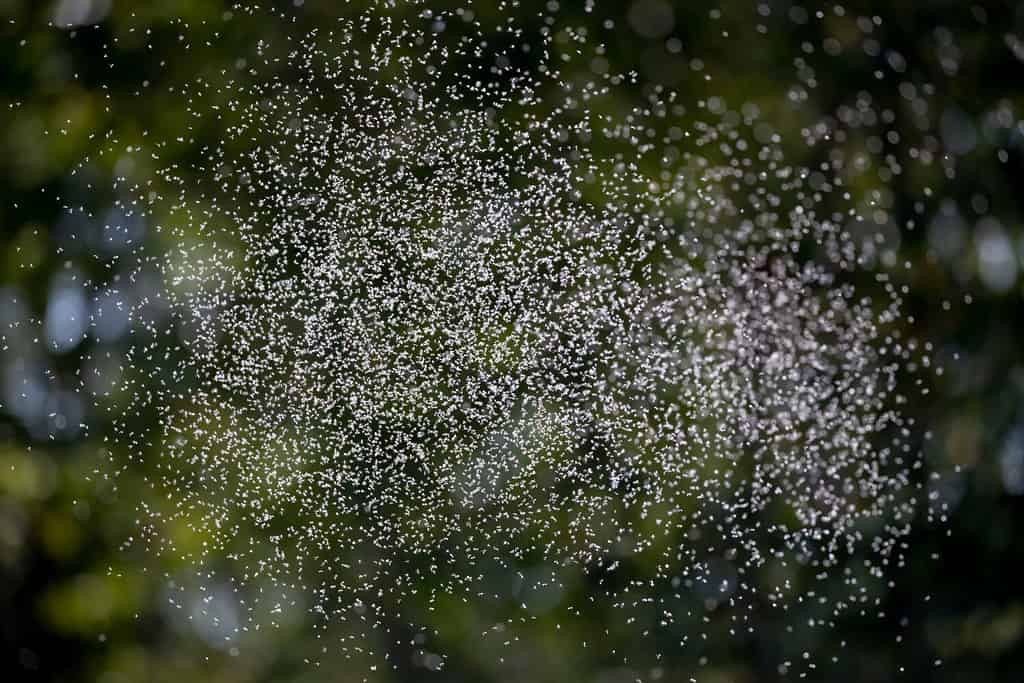
Swarming increases the likelihood of successful mating by bringing males and females together.
©Kendall Collett/Shutterstock.com
What Are Gnats Attracted to?
Various factors attract gnats, and their specific preferences can vary depending on the species.
Like many insects, carbon dioxide exhaled by animals, including humans, attracts gnats. They use this as a cue to locate potential hosts for feeding and mating. Gnats thrive in areas with high humidity or near water sources. They prefer damp and moist environments, such as wet soil, decaying vegetation, and overwatered potted plants.
Some gnats, such as fungus gnats, are strongly attracted to decaying organic matter like decomposing leaves, rotting wood, fruits, or vegetables. In outdoor settings, gnats may be attracted to the scent of dead animals or decaying organic matter, which can provide a food source. This is an important environmental purpose of gnats. These materials provide a breeding ground for them. In addition, certain gnats are attracted to sweet, fruity, or fermented odors. Overripe fruits, sugary beverages, and alcoholic beverages can draw them in.

Rotting fruit attracts gnats.
©Xolodan/Shutterstock.com
Gnats are attracted to light sources, including indoor and outdoor porch lights. They may congregate near windows and light fixtures. In addition, they are drawn to heat sources, such as the warmth of humans and animals. This attraction can make them a nuisance, especially in outdoor settings.
Flowering plants can attract gnats, as they are often drawn to the nectar and pollen. While visiting flowers, they may inadvertently help with pollination. Certain gnat species, like the soil-dwelling fungus gnats, are attracted to the moisture in the soil of houseplants. They lay their eggs in the ground, and the larvae feed on organic matter and plant roots.
What Can You Do?
It’s important to note that gnats can be a nuisance when drawn to indoor spaces or gatherings. To reduce their presence, you can take steps such as sealing cracks in doors and windows, eliminating sources of standing water, properly storing fruits and vegetables, and using screens and repellents when necessary. Additionally, addressing the conditions that attract gnats, such as excess moisture, can help reduce their numbers in and around your home.
How to Get Rid of Gnats in Your Home
Getting rid of gnats in your home can present a real challenge, but you can effectively eliminate them with patience and determination. Gnats love moisture and food sources, so the key to removing them is to eliminate these attractions and use several effective methods to trap or repel them.
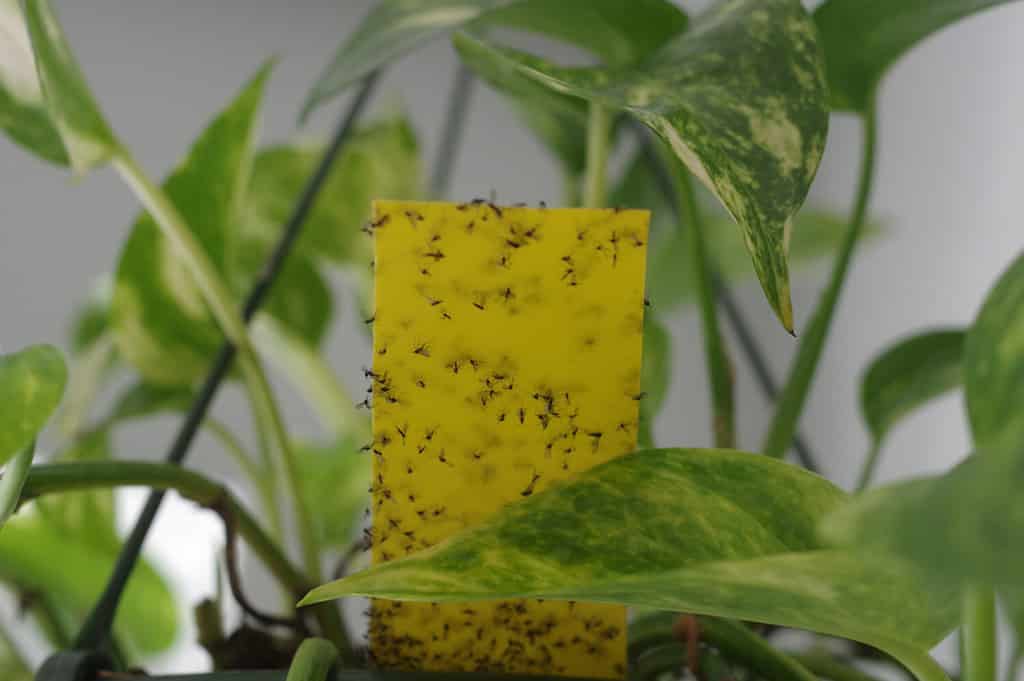
There are various commercial products, such as sticky pads, that eliminate gnats.
©Pixelbender36/Shutterstock.com
Here are a few ideas to help eliminate gnats in your home:
- First, identify where the gnats are coming from. They may be breeding in water-logged plants, damp areas, or near food sources.
- Gnats thrive in moist environments. Make sure there are no leaky pipes or standing water in your home. Avoid overwatering indoor plants. Check that the topsoil is dry before watering it again. Wipe down wet surfaces in your kitchen and bathroom promptly.
- Eliminate breeding sites. Check the soil for larvae (tiny, worm-like creatures) if you have potted plants. Remove any affected dirt and replace it with fresh, dry soil. Empty and clean trash cans regularly, as they can become breeding sites.
- Ensure food is stored or covered properly in sealed containers or the refrigerator. Clean up food and drink spills promptly. Use tight-fitting lids on food storage containers.
- Set up gnat traps. You can make a simple trap by placing a small dish of apple cider vinegar with a few drops of dish soap near the infested area. The gnats are attracted to the vinegar and trapped in the soapy solution. Sticky fly traps can also work well for capturing adult gnats.
Natural Repellents
Natural repellents like basil, lavender, or rosemary can help deter gnats. Place these herbs near windows or other gnat-prone areas. Essential oil diffusers with oils like eucalyptus or citronella can also be effective. There are various commercial gnat traps and sprays available.
Regularly clean and disinfect your kitchen and trash cans. Eliminate food residue and odors that attract gnats. Check doors and windows for gaps or holes and seal them to prevent gnats from entering your home.
You must be patient because eliminating gnats may take time, as you must break their breeding cycle. If the above solutions do not improve your gnat infestation, it may be time to call the pest control experts.
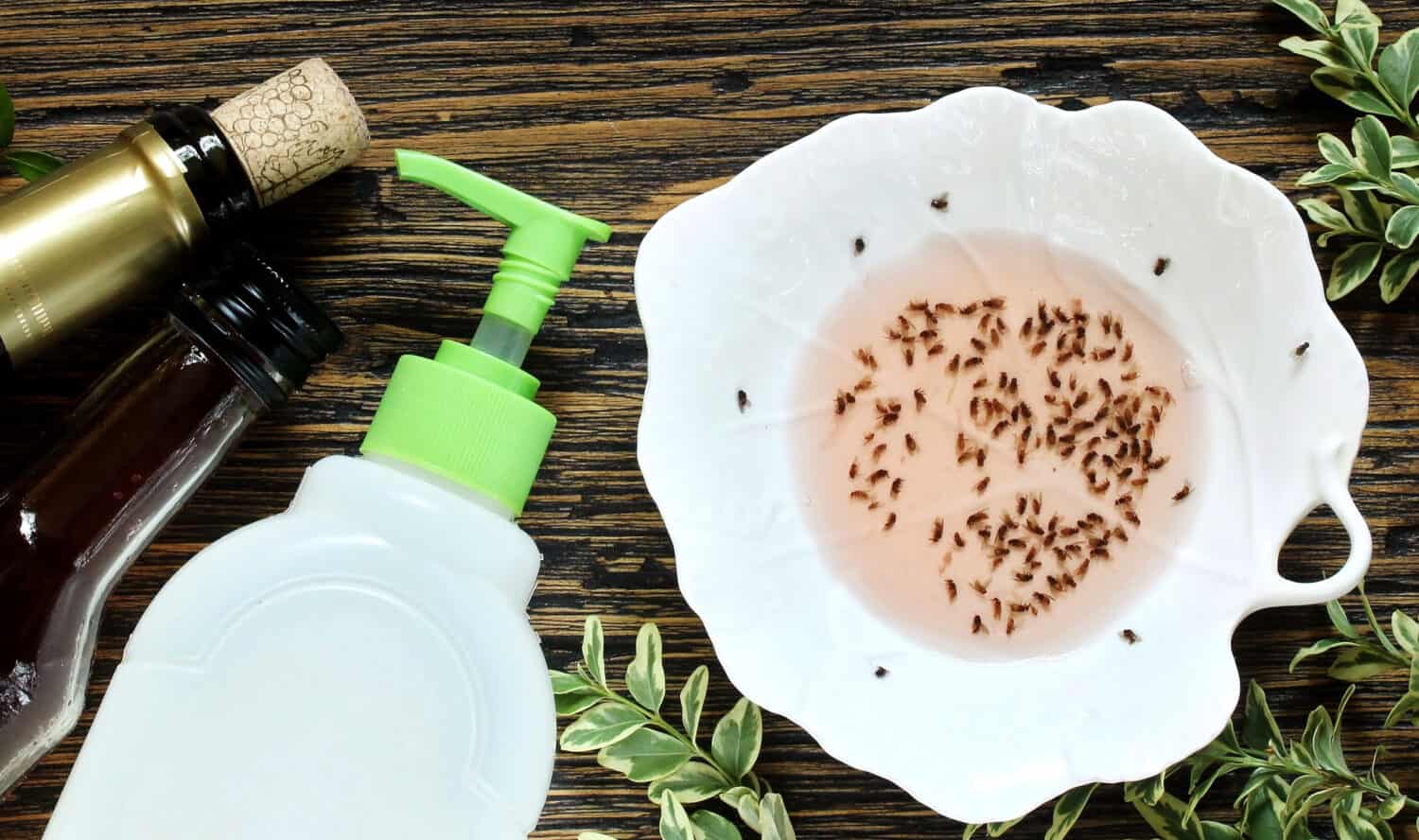
Get rid of gnats with a bowl of wine vinegar and a few drops of soap.
©Lyudmila Mikhailovskaya/Shutterstock.com
How to Get Rid of Gnats in Your Yard
Regarding your yard, there are other issues to consider if you want to eliminate gnats. Addressing a gnat infestation in your yard can be challenging, but it’s possible with the right strategies. Gnats in the yard are often attracted to moisture, decaying organic matter, and vegetation.
Here are some steps to reduce gnat populations in your yard.
- Gnats breed in moist environments. Eliminate sources of standing water, such as puddles, bird baths, clogged gutters, and overwatered areas in your yard.
- Improve the drainage in your yard to prevent water from pooling in low-lying areas.
- Gnats often congregate in tall grass and dense vegetation. Keep your lawn well-maintained by regularly mowing it and trimming overgrown plants.
- Clean up dead leaves, grass clippings, and other organic debris in your yard. Gnats are attracted to decaying matter.
- If you have a compost pile, you must manage it properly to prevent gnats from breeding.
- Consider using outdoor fans in seating areas to create airflow, which can help deter gnats. You can also use gnat traps designed for outdoor use in your yard. In addition, you can also use gnat traps specially designed for outdoor use in your yard.
- As a last resort, you can use insecticides labeled for outdoor use to treat gnat-infested areas. Remember to use insecticides sparingly and responsibly.
Natural Solutions
While gnats have a purpose in pollination, you can still use gnat-repelling herbs and flowers in your garden. Some options include marigolds, lavender, and basil. In addition, consider placing citronella candles or torches in outdoor seating areas to deter gnats. Neem oil is a natural insect repellent. Mix it with water and spray it on plants and the yard to repel gnats.
Be mindful of how much you water your lawn and garden. Overwatering can create conditions that attract gnats. Gnat control in the yard may take time, so be patient and persistent.
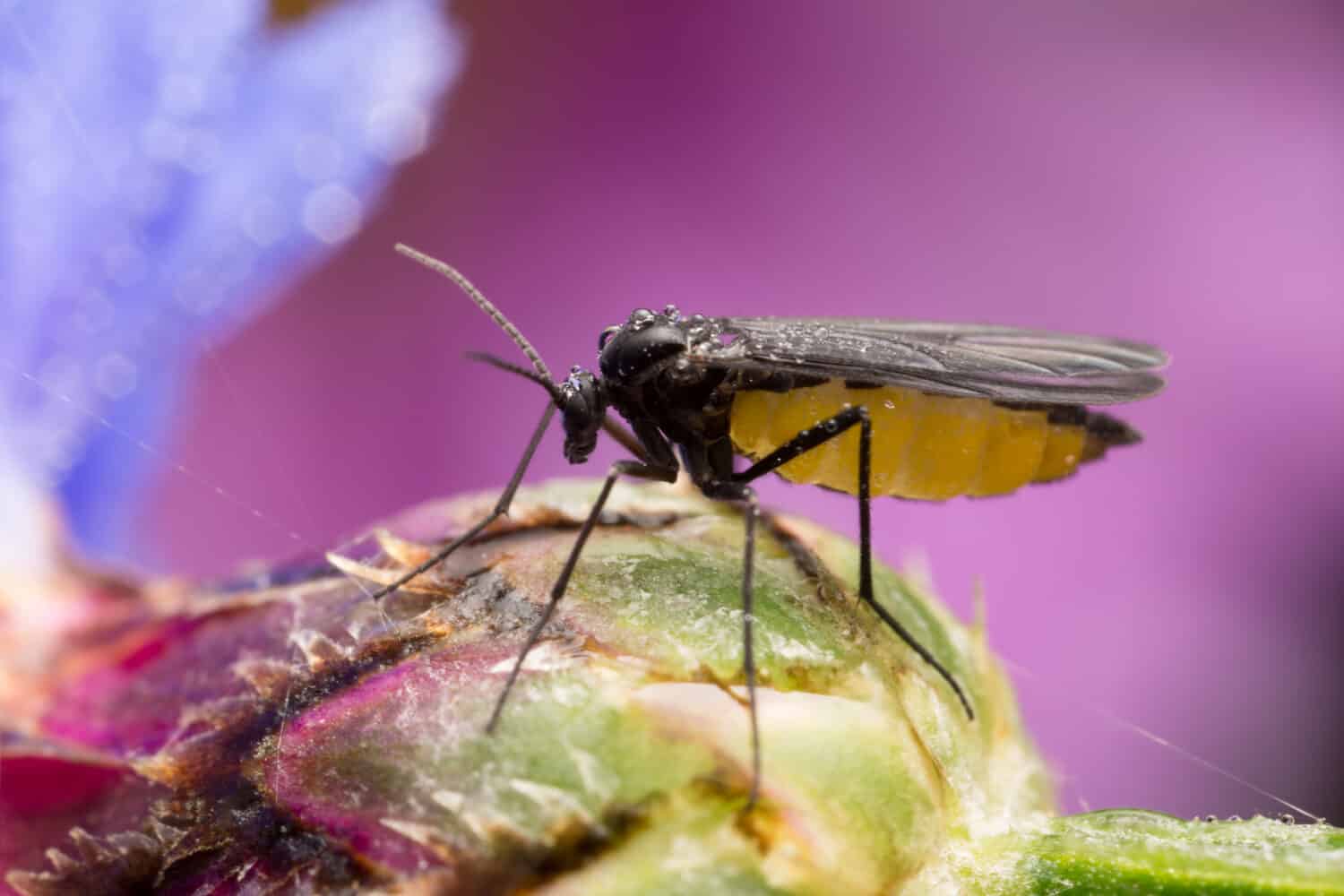
The purpose of gnats includes decomposing organic matter and being food for other animals, such as birds and bats.
©Henrik Larsson/Shutterstock.com
Conclusion
Although unpleasant, there is a purpose for gnats. They are essential to our ecosystem. Like many other less comfortable elements of nature, gnats are part of Earth’s rich tapestry of biodiversity.
Remember that it may be challenging to eliminate gnats from your home. Still, reducing their breeding sites and creating less favorable conditions can decrease their population and make outdoor spaces more enjoyable.
The photo featured at the top of this post is © iStock.com/Tomas Klejdsz
Thank you for reading! Have some feedback for us? Contact the AZ Animals editorial team.







